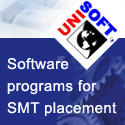
|
|
Volume 3, Issue No. 7
|
Thursday, July 18, 2001
|
 |
|
Featured Article
|
|
Book Review
Reviewed by Dave Fish (davef  ), Pandion Electronics, Inc. ), Pandion Electronics, Inc.
|
In "Printed Circuit Assembly Design", Leonard Marks and James A. Caterina describe the processes, methods, and tools used in designing printed circuit assemblies, the considerations that influence how to lay-out a PCA, and the typical design process and relationships between process elements. The book explains the different approaches for developing and documenting designs and suggests approaches for organizing these activities. There are two types of books on printed circuit assembly design. These books either: (1) focus on solving a specific issue, such as high speed digital design, EMI, or power supply design or (2) cover a broad range of issues of general application to most designs. "Printed Circuit Assembly Design" fits in the latter group and fills a void that is at least 10 years old.
The authors, Marks and Caterina, are very experienced in electronic design and it shows in their book. Mr. Marks has over 35 years of experience in printed circuit assembly design and manufacture. Mr. Caterina has been designing printed circuit assemblies for over 28 years. Their book is well written, illustrated, organized, and edited.
"Printed Circuit Assembly Design" is a road map or framework that highlights or sorts through the issues that concern [or should concern] designers. It describes the proper procedures and considerations necessary to design an assembly. While it is loaded with design tricks and specific practices that are difficult to learn anyplace other than at work, it is intended to focus on broader concerns. Unfortunately, the book quickly "runs-out of information". This is because once a designer makes the first level decisions presented in the book, the specifics of material selection, "real estate" partitioning, and power and cost budgeting quickly loom into view. This is when the authors' decision to exclude references and suggested reading suggestions leave the reader without direction.
Principal chapters of the book are:
- Design Process Flow covering requirements allocation and functional partitioning, circuit design, mechanical design, board layout, board fabrication, assembly, and test & inspection.
- Circuit Board Layout discussing mechanical definition, schematic generation, component part data, part / function placement, circuit routing, circuit performance, routing the interconnects, and checking & analyzing the routed results.
- Design Quality presenting design reviews, checking, producibility evaluation, testability evaluation, PCA reliability, and maintainability & repairability.
- Documentation addressing circuit board artwork, drilling & machining data, bare board fabrication data, assembly data, part & documentation numbering, and archiving data.
- Design Revisions describing schematics & parts list revisions, layout changes, bare board modifications, and assembly modifications.
- Design Organization and Management focusing on structure of the design organization and external interfaces.

POST A TALKBACK TO THIS ARTICLE!
The SMT Express is brought to you by SMTnet.
|
|
|
Sponsors
|



|
|
About This Newsletter
|
|
The SMT Express is a periodical featuring assembly solutions from your peers and vendors. We, at SMTnet.com, have designed this newsletter to bring useful information to the mailboxes of electronics manufacturing professionals.
Contributors Wanted!
We would like to encourage industry professionals to submit well-written technical articles covering issues crucial to the Manufacturing industry. Make your name known to thousands of SMT Express readers. Help promote your goods and services, by sharing your ideas. Be known as a mover and leader within this rapidly changing industry.
Get more mileage out of previously released material. If you have presented a paper at a conference or been published within a magazine, trade journal, or web site, you can publish in the SMT Express. Recycling your papers in this way will give you and your company exposure and contribute to the industry as a whole. The SMT Express is archived on www.smtnet.com so that community members have continual access. Please read the submission guidelines and Contact Us regarding article and news submissions.
- Thanks in advance
To Subscribe:
Click here to register with SMTnet.com to receive this newsletter and many other benefits. It's absolutley free!
Newsletter Archives:
Click here to to visit the SMT Express home page. A list of archives can be found there in the menu on the left.
|
|